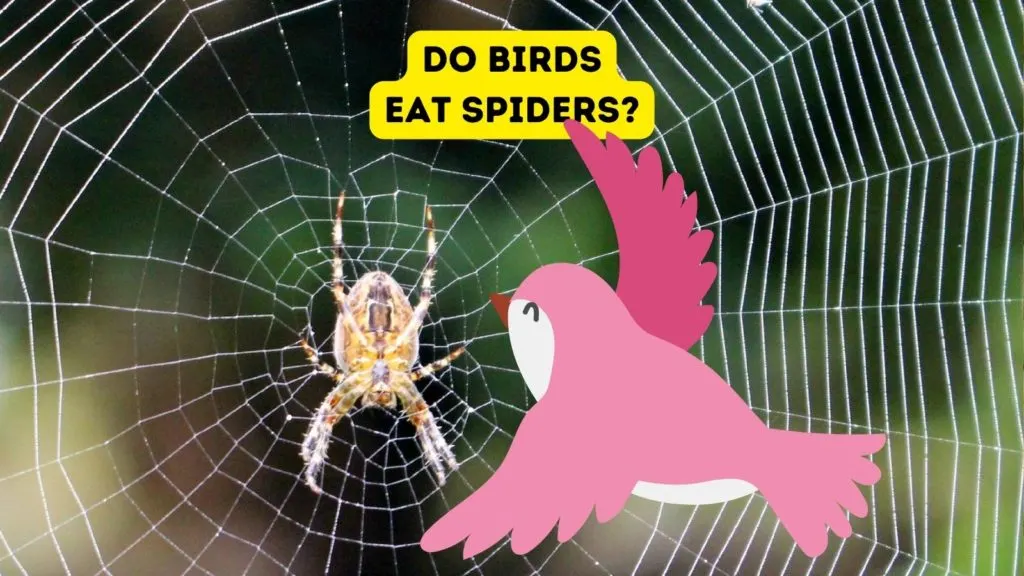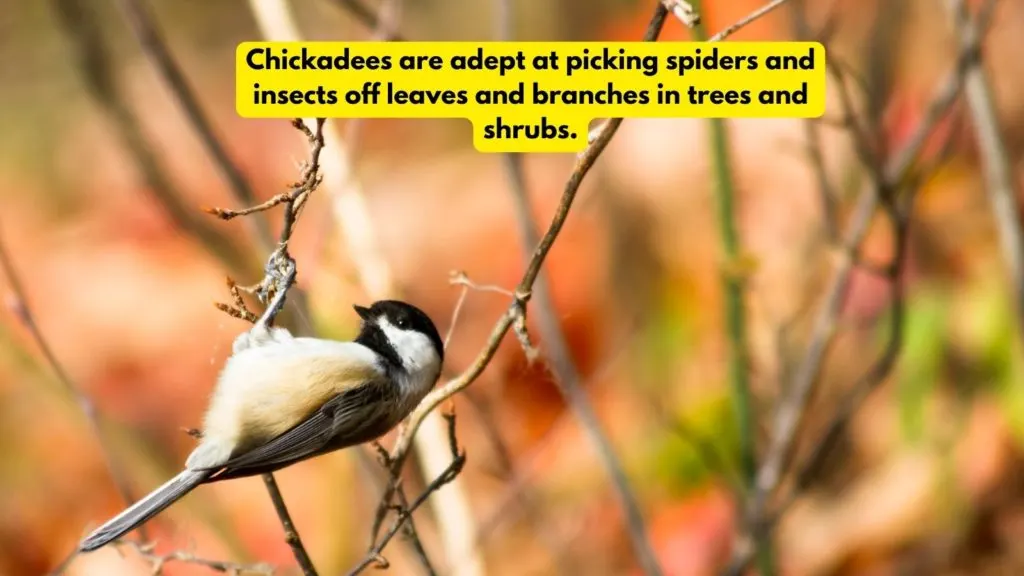Picture this: you’re enjoying a peaceful morning in your garden, coffee cup in hand, when suddenly you see a small bird swoop down and snatch up a spider from its delicate web. You blink twice, caught off guard by the unexpected breakfast choice of our feathered friend. This surprising occurrence poses an intriguing question – do birds really eat spiders?
Despite their fluffy exterior and beautiful melodies, birds are known for being opportunistic feeders with diverse diets. The image of birds pecking at worms might dominate popular culture but these creatures’ eating habits extend far beyond that stereotype. If the idea of birds feasting on creepy crawlies piques your curiosity or makes your skin crawl, then buckle up! We’re about to take an enlightening journey into the fascinating world of avian dietary habits.

Which Birds Eat Spiders?
In contrast to common wisdom suggesting birds prefer worms, many enjoy an eclectic menu with spiders as the delicacy of choice! One prime example is the Eastern Kingbird, an agile flyer, renowned for its proclivity toward devouring airborne arachnids.
Another bird species with a commendable appetite for spiders includes the Phainopepla, a crested songbird found in Mexico and Southern United States and a relative of the waxwings. This songster consumes up to 1.5 times its body weight daily on a diet heavily featuring spiders!
Species like Flycatchers and Thrushes often seeking out orb-weaver or wolf spiders. Attracted by their large size and high nutritional value, they provide cellulose necessary for avian digestion.
Other birds that eat spiders include:
- Robins: These birds are known for their varied diet, which includes a significant amount of insects and spiders.
- Wrens: Small in size, wrens are agile hunters, often seeking out spiders and insects in tight spaces like tree bark crevices and under leaves.
- Warblers: Many warbler species eat spiders, especially during migration when they need high-energy foods.
- Chickadees and Titmice: These birds, while often seen at seed feeders, also feed on insects and spiders, particularly when feeding their young.
- Nuthatches: Known for their tree-climbing antics, nuthatches pick spiders and insects off tree barks.
- Woodpeckers: Apart from pecking for insects in wood, woodpeckers also consume spiders. Their strong beaks allow them to extract spiders from their webs or hiding places.
- Swallows: These aerial insectivores often catch spiders in flight or pick them from their webs.
How to Encourage Birds to Eat Spiders

Nature has designed a perfect, non-toxic pest control agent: Birds! They not only add melody to your mornings but also play the role of efficient spider hunters.
To create a spider-free space at your home while nurturing Mother Nature, inviting birds is an excellent solution. Birds like wrens, sparrows or chickadees are fantastic natural ways to control the arachnid population as spiders form part of their diet.
Cultivate a bird-friendly zone in your backyard or balcony by installing bird feeders and birdbaths. Feeders with seeds and water will invite hungry avians seeking refreshments. In the process of visiting for a meal or a bath, these winged friends will notice little creepy crawlies lurking around, making them an easy prey. Remember to strategically place these installations away from dense vegetation where spiders usually hide to present them as an open-season feast for our feathered friends!
Be sure to let the birds do their job safely–don’t spray the spiders with insecticides! Sprays can be deadly to birds so just let Mother Nature handle the extermination task for you and keep the birds safe.
Spiders Are More Than a Meal–They Provide Building Materials
Imagine a bird-builder extraordinaire, intently weaving together twigs, feathers and moss to create its work of art dwelling. Now imagine an unexpected, yet utterly remarkable tool they use for the job – spider webs. Yes! these avian architects often employ the delicate threads of a spider’s web as structural binding components in their nests.
Spider’s silk is extremely strong and flexible with adhesive qualities, superbly designed by nature for endurance. When birds embrace it in their construction process, spider’s silk allows them to fasten diverse bits of debris more securely than any synthetic glue available in human hardware stores could ever offer. Not only providing added tensile strength to the nest but also making nests adaptable to expansion as hatchlings grow!
Even hummingbirds make use of spider silk in their nests to lend elasticity to the nests. Initially the size of a walnut cup, the nest can stretch and expand as the hummingbird babies grow thanks to the adaptive potential of woven-in spider silk.
What Similar Food Can You Buy for Them?
Mealworms are by far the closest commercially available bird food comparable to spiders’ nutritional composition. These tiny insects are excellent sources of protein and fat, similar to what a juicy spider offers our avian companions.
Suet is another alternative packed with necessary proteins and fats mirroring spider nutrients; it also has the added bonus of lasting longer in feeders.
Remember; variety is key to an enriched diet- mix these in with standard bird seeds for a well-rounded meal that will attract diverse species. Enjoy observing healthier, happier birds with these suited substitutes for their cherished arachnid treats!
Frequently Asked Questions
Will having birds around reduce the number of spiders?
Yes, having birds around your area can contribute to a decrease in the spider population. Birds like blue tits and great tits often consume spiders and even feed them to their chicks. Given the opportunity, many bird species will gladly eat spiders, which can naturally help manage their numbers in your garden or outdoor space.
Are spiders that build webs at risk of being eaten by birds?
Spiders that construct webs are indeed at risk from predacious birds. While not all birds primarily feed on spiders, species such as cardinals, robins, and starlings may eat spiders if they come across them. Web-building spiders can become easy prey for birds that are foraging for food.
Do birds eat tarantulas?
We often see tarantulas near our home, especially in the spring and autumn. I’ve never seen the smaller birds that hang out around our bird feeder pay one any mind–but larger birds just might want to put a tarantula on the dinner menu! These birds might eat tarantulas:
- Roadrunners: These ground-dwelling birds are opportunistic predators and are known to eat a variety of prey, including tarantulas, other large spiders, scorpions, and small reptiles.
- Large birds of prey: Some large raptors, such as hawks or eagles, might prey on tarantulas, especially in regions where these spiders are common.
- Guineafowl: In their native habitats, guineafowl are known to eat a variety of insects and small animals, including spiders like tarantulas.
Is a tarantula hawk a bird?
Despite their name, tarantula hawks are not related to birds. The term “hawk” in their name is metaphorical, relating to their hunting prowess and not indicative of their classification in the animal kingdom.
Instead, the tarantula hawk is a type of wasp! Tarantula hawks belong to the family Pompilidae and are among the largest wasps, known for their size, bright coloration, and powerful sting.
We see tarantula hawks flying low over the grass, looking for tarantulas, and usually every year I see one of two dragging their prey back to the nest.
Their life cycle has the makings of a horror movie. Here’s how the tarantula hawk operates:
- Hunting: The female tarantula hawk actively searches for tarantulas and, upon finding one, engages in a battle if necessary.
- Sting: The wasp stings and paralyzes the tarantula. The sting of a tarantula hawk is considered one of the most painful insect stings in the world (which is why I give them a WIDE berth when I see one!)
- Reproduction: After paralyzing the tarantula, the wasp lays an egg on the tarantula’s body. When the larva hatches, it feeds on the still-living but paralyzed tarantula.
Tarantula hawks are found in regions where tarantulas are abundant, such as in the deserts of the southwestern United States and parts of Central and South America.
Which birds typically don’t eat spiders?
Birds that typically do not eat spiders include:
- Nectar-feeding birds: Birds like hummingbirds, which primarily feed on nectar from flowers, are unlikely to eat spiders. Their diet mainly consists of nectar supplemented with small insects and pollen.
- Grain and seed-eating birds: Many species of finches, sparrows, and doves primarily feed on seeds and grains and are less likely to consume spiders. These birds have adapted to a diet consisting mainly of plant material.
- Fruit-eating birds: Birds such as orioles, certain parrots, and some tropical species that primarily feed on fruits are less inclined to eat spiders. Their diet consists mostly of various fruits, berries, and sometimes nectar.
- Some waterfowl: Ducks, geese, and swans, which are primarily herbivorous, feeding on aquatic plants, seeds, and sometimes small aquatic animals, are less likely to eat spiders.
It’s important to note that while these birds generally do not eat spiders, many bird species are opportunistic feeders. This means that they might occasionally eat foods outside their usual diet, including spiders, especially if their preferred food sources are scarce.
More Posts You Might Like
- Does Bird Seed Expire? - May 11, 2024
- How Big Are Baby Hummingbirds? - May 5, 2024
- How to Prevent Mold in Hummingbird Feeder - May 2, 2024
